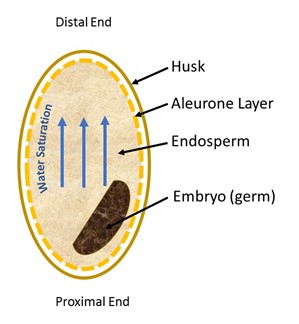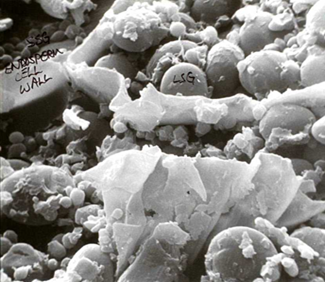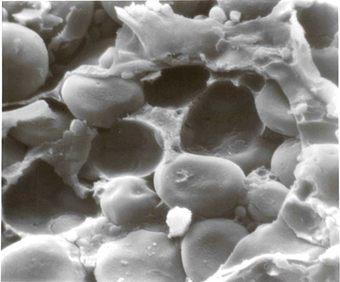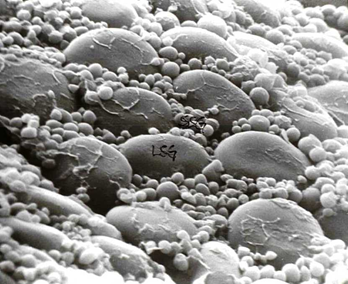The definition of friability is how easily something crushes under pressure. In general, the more modified a malt is, the more crushable it is. The instrument used to assess a malt’s crushability, or modification, is a Friabilimeter (Pfeuffer). The analysis involves crushing a sample of malt with the Friabilimeter, collecting the fraction that remains in the instrument, and sifting that portion on a specific sized screen. Each fraction is weighed and recorded. Then a simple calculation provides the % friability and % unmodified.
Figure 1. Images of the Pfeuffer Friabilimeter a) with the protective housing, b) without the protective housing, c) with the drum removed.
Photo Credit: Montana State University, Hannah Turner
Malting harnesses the natural process of grain germination to modify hard barley kernels into friable, starch accessible grains for the brewing process (Figure 2). Modification involves the enzymatic degradation of seed structures including the endosperm cell walls (primarily made of B-glucan in barley) and a protein surrounding the starch granules which forms the endosperm matrix. These aspects are the basis of grain rigidity which is reduced as malt modification progresses. The degree of modification (Figure 3) is correlated to many factors of interest to the brewer and is therefore an important measurement of malt. A Friabilimeter offers one way to evaluate modification by measuring the crushability of the malted grain. |

Figure 2. Basic anatomy of a barley kernel and water saturation flow. Image credit: Katie Fromuth. |

Under-modified malt having remnant cell walls remaining
|

Protein matrix with starch granules embedded |

Well modified malt with large and small starch granuels exposed |
Figure 3. Scanning electron microscope images of barley endosperm showing increasing levels of malt modification (left to right), ca. 10,000X magnification.
Image credit: Dave Thomas
- Follow the manufacturer’s recommendations and check the instrument settings at a regular interval.
- Pfueffer provides a standardized malt sample for calibration of the instrument. Use this sample for subsequent validation of instrument function.
- According to the manufacturer, malt samples should be between 3.5 and 5% moisture. Moisture above 5% may produce falsely low friability results.
- Friability results are impacted by protein content of the grain. At the same level of modification, friability results will be higher for malts with low grain protein and lower for malts with high grain protein.
- Friability measurement is intended for malted barley. It is not appropriate for other malted grains.
- Friability is not an absolute number and should never be considered in isolation, as is true for all malt measures. Friability is most informative to maltsters when tracking results over time and considering data specifically within individual lots of barley.
- The official method provides instruction for calculating friability and % unmodified malt. These two pieces of information can provide specific information on how well modified the malt is. A third measure, the % weight of whole kernels from the unmodified portion, can also provide important information about a malt. Depending on who you are communicating with, the latter two measures can sometimes be referred to as PUGs (Partially Unmodified Grains aka % Un-modified) or WUGs (Wholly Unmodified Grains aka % Whole kernels). Table 1 below explains how to interpret these three measurements.
| Measurement | Interpretation Guide |
|---|
| % Friability | Overall friability of the malt. Higher values indicate increased levels of malt modification. This value can be impacted by variety, grain protein, environmental growing conditions, malt moisture, kilning regime and grain modification. |
|---|
| % Un-modified | Estimation of un-modified distal ends of barley kernels. Modification progresses from the embryo end of the grain toward the distal end. High values here may indicate modification has not progressed far enough and malting regime changes are needed. |
|---|
| % Whole Kernels | Whole kernels have not germinated in the malting process for some reason. This could indicate issues of grain viability, dormancy, water sensitivity, or any other number of reasons which would cause grains to not germinate. High levels here indicate a need for the maltster to re-consider aspects of the grain’s germination analysis, steeping regime used, or other causes of poor germination. |
|---|
Table 1. Information gained from the three measurements calculatred through MOA Malt 12.
A Big Thanks To...
Hannah Turner, Aaron MacLeod, Dave Thomas, & Katie Fromuth
